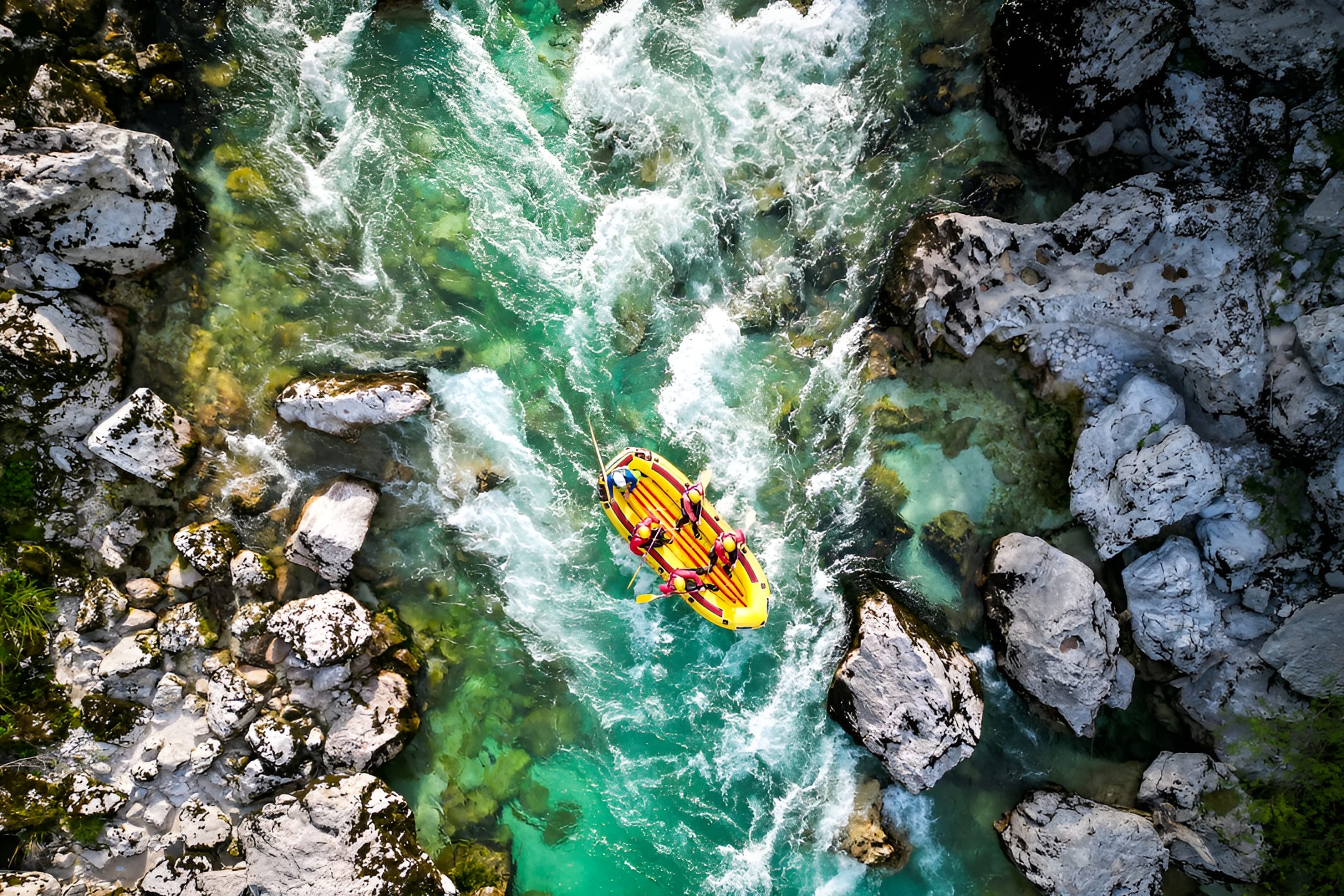
Ultimate guide to rafting on Soča River
Experience the thrill of rafting on Slovenia’s Soča River with crystal clear waters, stunning alpine scenery and rapids for all levels.
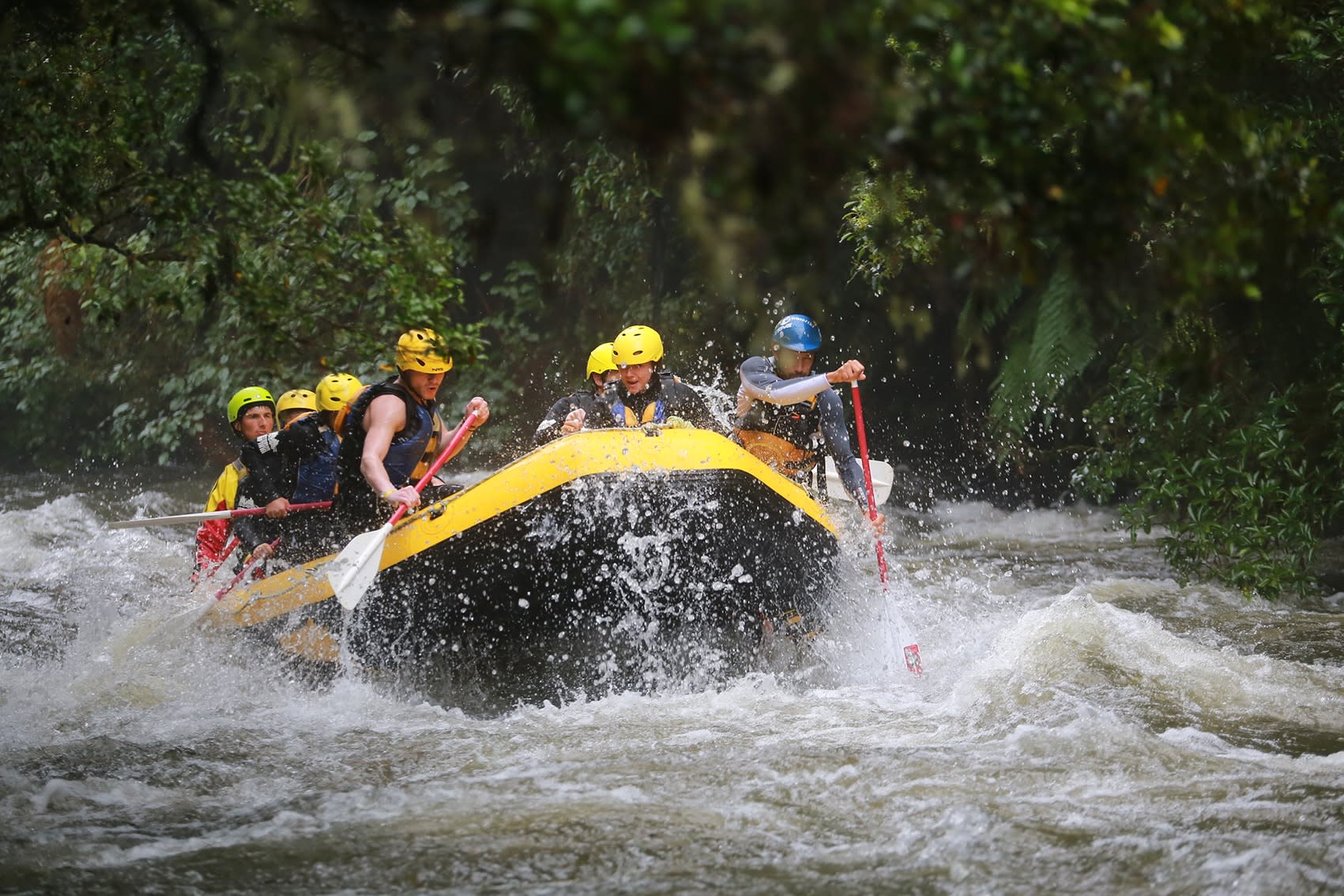
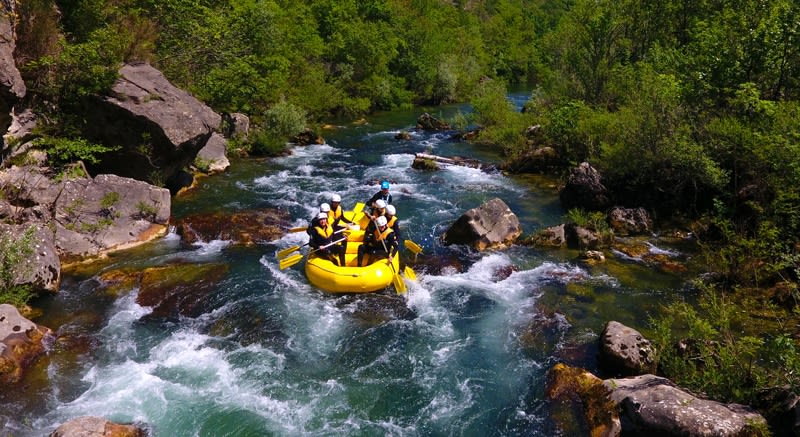
Rafting is a highly popular whitewater sport that immerses its participants in stunning surroundings, of mountain valleys, gorges and canyons and in rivers of all different shapes and sizes. Joined by a minimum of three other people, including the instructor, you will paddle your inflatable raft as a team to scale choppy waves, difficult rapids and raging currents. Get out on the water and share this adventure with friends and family, as it’s a sport dependent on teamwork. Rafting is practiced in some stunning locations worldwide, and can make for an unforgettable holiday or group experience – check out our top rafting destinations.
Rafting is an accessible sport, that is often family-friendly, with a minimum age of sometimes as young as 6 years old. This sport at beginners level requires participants only to have a minimum level of physical fitness, but requires them to be able to swim. With an instructor in the raft to help participants to navigate the waves and rapids, and to give instruction on how to maneuver around obstacles, this sport is accessible to beginners.
This sport is predominantly practiced on the same rivers that whitewater kayaking and hydrospeed are. Whitewater rafting, however, offers even more of an adrenaline rush, due to the ferocity of the waters, waves and rapids that can be traversed. The classes of whitewater river that rafting can be practiced on are higher than those of hydrospeed and whitewater kayaking. See our complete guide to hydrospeed and complete guide to whitewater kayaking for more information on these other exhilarating whitewater sports.
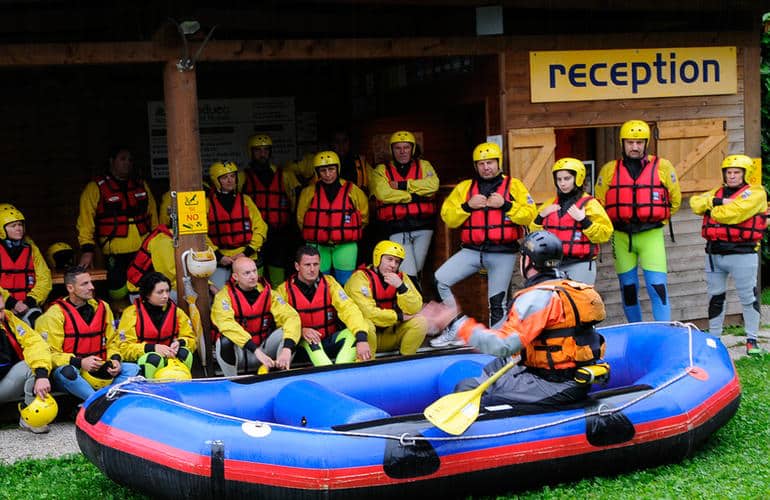
Beginners to this sport are not required to bring sports equipment to the site of the activity. Rafting participants are really only required to bring their own swimming costume, to be worn underneath the wetsuit, provided by the instructor. Bringing a towel to dry off with after the rafting session is highly recommended.
It is also recommended to bring sunscreen – dependent on the location this may be highly necessary as you will be in a raft out in the sun for a number of hours. A bottle of water to re-hydrate after the activity and a change of clothes are also highly recommended. Shoes that you don’t mind getting wet, to wear in the water, are also recommended and may be necessary dependent on the individual activity and location.
The instructor will provide the inflatable raft, predominantly made of either PVC or synthetic rubber. Rafts vary in size, dependent on the amount of participants, the standard raft fits between 4 to 8 people, including the instructor. Rafts of this size will need a minimum of 3 participants plus the instructor, to be able to be taken out on the water. The guide will also provide the correct paddles for the type and class of river that you will be rafting on.
Other equipment that the instructor typically provides for the participant is a full body wetsuit, helmet and lifejacket. They may also provide neoprene waterproof boots for wear in the raft, and subsequently in the water, if you fall out.

Your instructor will give you a briefing before you begin your rafting experience. During this talk they will inform you of the necessary safety information, including how to best stay within the raft and what to do if the raft is overturned, as well as how to use the paddles. If the itinerary includes specific rapids or drops that need to be maneuvered in a specific way, your rafting instructor will explain how to maneuver it beforehand. The instructor will show you how to get kitted up in your full body wetsuit, helmet, life jacket and neoprene shoes (if required). You will help carry the raft, as will the rest of the group, whether from the transport you take from the rafting school’s base or from the base if it’s near the river, to the water’s edge and begin your session.
The type of rafting experience that you have will depend on the location and the class of whitewater there. As a group, of minimum 3 people – plus the instructor, you will use your paddles to navigate the water’s course. The instructor will most likely be sat at the back of the raft, helping the group to follow the route and giving advice on how to maneuver around obstacles. Depending on the class of rapids that you come across on your rafting experience, you will have to work as a team to safely make your way through rocky and choppy courses.
Most rafting tours last for a 10km to 15km run of river, with approximately 2 to 3 hours spent on the raft. Unlike kayaking or canoeing, longer itineraries are usually not rafted as rafting is usually more physically demanding.
It’s almost certain that you will get wet, but on the class of rapids that most beginners rafting sessions will take you through, you are unlikely to be knocked out of your raft. If you are, however, you will be wearing a life jacket as an aid, and will be helped to find your way back to the raft. Beginner’s level rafting activities are safe, provided that participants follow the safety information they were given in the pre-activity training.
When your rafting activity comes to an end, you will give your paddle to the instructor to collect and then help to carry the raft out of the water, along with the other rafting participants. After taking the raft back to the rafting school’s base, if near the river, or helping to load it onto the transport, you will be taken back to where you left your belongings. Here you will be able to change clothes, have a short debrief and get on your way.
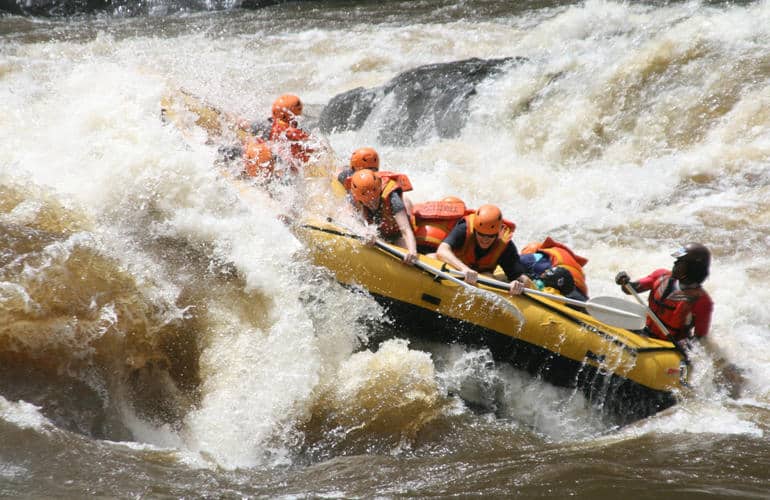
Rafting locations are graded on an international scale in terms of their level of difficulty to those on the river, in terms of the dangers that they pose to rafters on them, whether that be from rocks and natural obstacles, powerful rapids or strong waves.
Most commercial rafting happens on class II-III whitewater, with the occasional IV rapid. On class I-II it’s slow and physically demanding, as rafts are not light and you will be working as a team somewhat unaided by current, to move the raft down the river. Usually on class I-II rivers canoeing and kayaking is practiced, whilst from classes II-III onwards, rafting is preferred.
The classes of whitewater run from I to VI, but can vary within their class, with difficult class III’s and easy class III’s offering rafters different thrills. Rivers themselves can vary in class, with some parts of the river’s course offering a class II level course, whereas further downstream there may be rapids that fit the class IV categorisation.
River classes can also change depending on the water flow – dependent on the time of year too. With heavy rains increasing the water capacity and speed of an already difficult class III, this could be recalculated as a class IV and the activities undertaken on these rivers would need to be altered.
Many activities adapt the boat types that they use, to the seasonally changing river water levels. For example, it is customary to have rafting in spring and autumn shifting to inflatable canoes or kayaks in the summer when water levels are low.
The first class is categorised simply as fast moving water, with the possibility of very small waves, requiring only a basic level of rafting skill.
This class requires only marginally higher rafting skills. Class II is fast moving water, with the potential for some maneuvering to be done, due to rocks or minor obstructions. This class of river will still have an easy to navigate, simple route.
Requiring some prior rafting experience, rivers of this class will have small waves – up to 4ft in height and some small drops. An example of a river of this class is the Durance River – Embrun, France. A marginally more difficult river would be the Soca River – Bovec, Slovenia, categorised as a class III/IV.
Expect severe waves, powerful long sections of rapids and a number of obstacles and obstructions. These rivers require a lot of maneuvering and a high level of rafting expertise. An example of a river of this class is the Kalaritikos River – Arta, Greece. A slightly more difficult river in this class would be the the Noce River – Dimaro, Italy, which is usually categorised as a class IV/V.
These rivers will have large waves and complex, powerful rapids. There is also the potential for large drops – expert rafting is required to navigate this class. A famous example of a river of this class is the Zambezi River – Zambia/Zimbabwe.
This class is deemed ‘unrunnable’ and will be attempted only by very few – if any, professional rafters. Highly dangerous, extremely powerful rapids and massive waves.
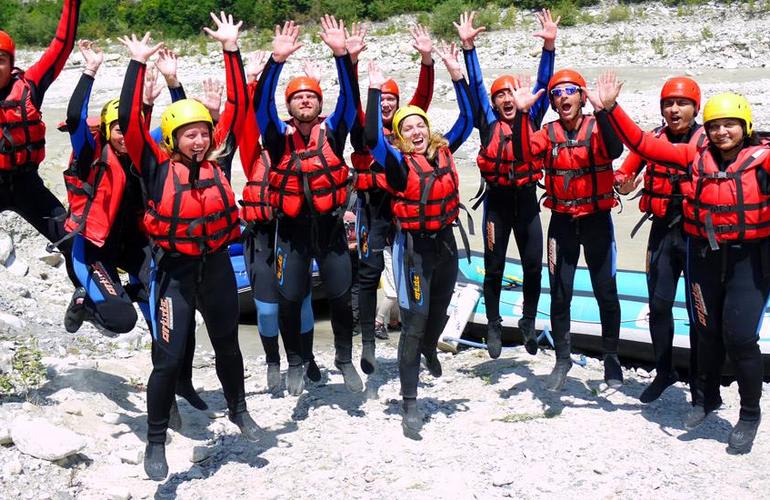
Minimum Age: This is dependent on the rafting school and the river, but the minimum age for participants can be as young as 6 years old. Minors under the age of 14 years will need to be accompanied by a parent/guardian, and those under 18 years old will need a parent/guardian’s written permission.
Physical fitness: All participants must be able to swim and must have at least a minimum level of fitness.
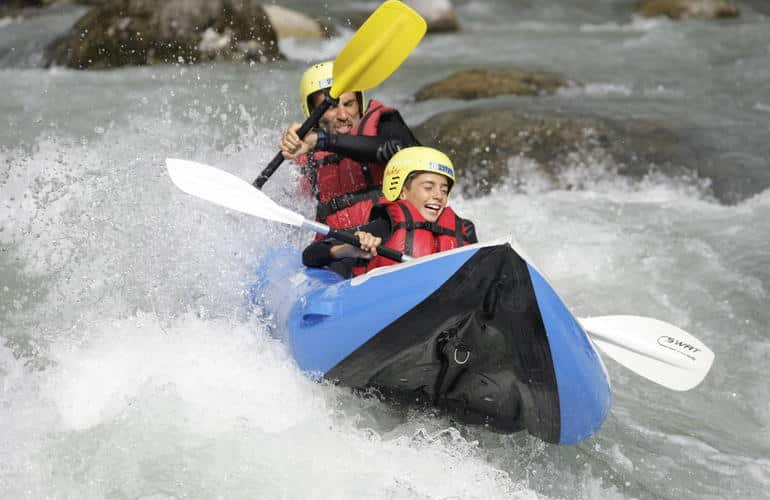
A highly popular and well-known sport across the globe, rafting has a number of equally exciting variations and activities similar to it.
A canoe-raft is a two person inflatable canoe shaped raft, in which two persons paddle and navigate a majority of the same choppy water courses as rafters.
Mini-rafting is practiced in locations where the river’s course may not have enough space for larger rafts. It is also practiced when there are not enough people to participate and take a full-size raft out on the water. These smaller rafts, that fit 3 to 6 people, are great for learning the basics of rafting and for some close-knit teamwork. Mini-rafting doesn’t always require the instructor to be in the boat, they usually follow by the side in their own boat to give help and guidance.
For more information about rafting check out our whitewater articles.
Read about our picks of the best rafting destinations in Europe.
Check out our rafting activities.